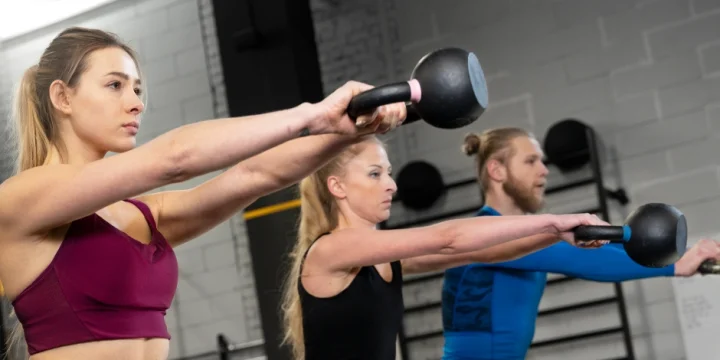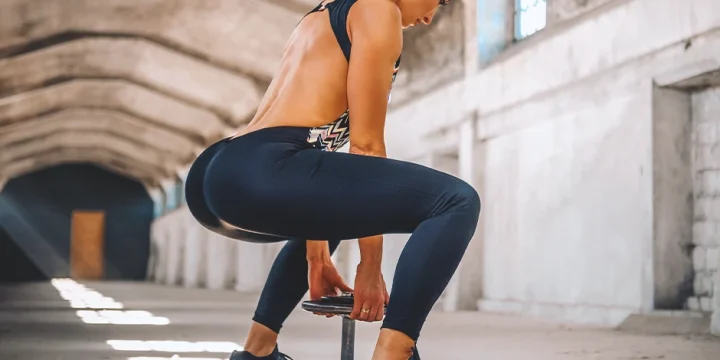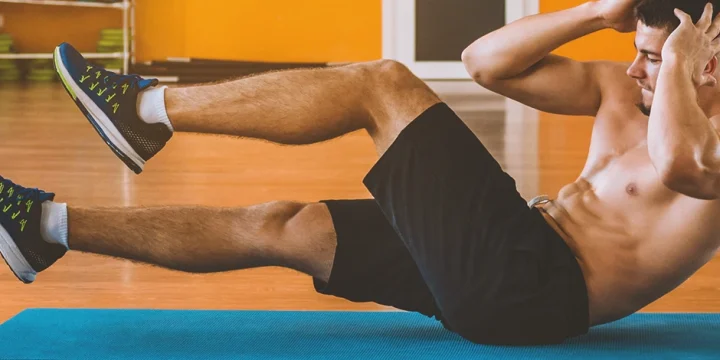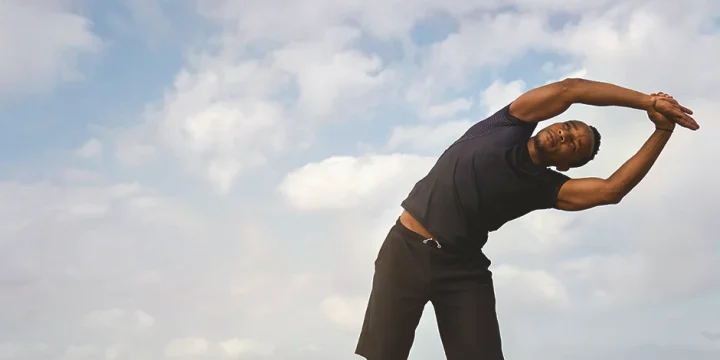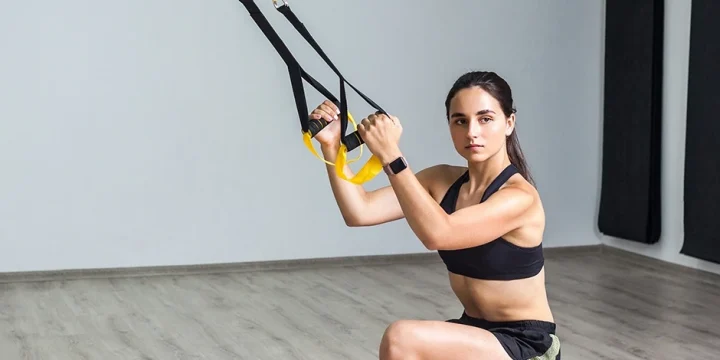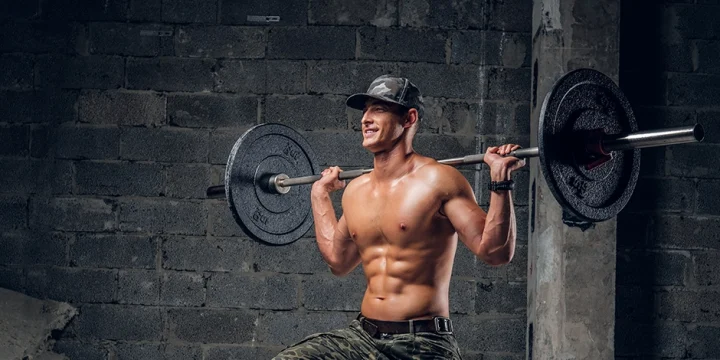As a fitness trainer with over a decade of experience, I haven't been a stranger to training men over the age of 50.
And while I make sure they exercise with the right intensity, I also ensure they perform exercises that best suit the physical effects of aging.
So, over the years, I have devoted weeks of research to craft a training program tailored specifically for men over 50 to maintain muscle mass while ensuring safety and well-being.
Let's dive in.
Quick Summary
- The best workout for men over 50 includes exercises that target major muscle groups in both your lower and upper body, such as reverse lunges, hip thrusts, planks, and lat pull-downs.
- Before commencing any exercise program, obtaining medical clearance from your doctor and undergoing a comprehensive physical check-up is crucial.
- According to a study on PubMed, working on the elliptical places minimal stress on your joints, making it ideal for men over the age of 50.
- Start with a slow and steady approach, gradually increasing the intensity and duration of your workouts over time.
Full-Body Workout for Men Over 50

After carefully reviewing all my personalized workout plans, I've put together the best workout plan for men above the age of 50.
1. Warm-up
Before starting your workout, do a 10-minute session on the good compact elliptical trainer.
I've found this to be a convenient cardiovascular exercise for men over 50. According to a study on PubMed, working on the elliptical places minimal stress on your joints [1].
2. Reverse Lunge
The reverse lunge is a great way to begin this workout routine.
While it may place a little stress on the knees, here are a couple of tips to minimize that stress:
- When performing lunges, shift your focus towards taking the body down rather than solely moving it backward.
- Avoid twisting the knee out or in throughout this exercise, as it can lead to injury.
To perform a reverse lunge:
- Position your feet at a shoulder-width distance and rest your hands on your hips.
- Move your right foot backward, ensuring that the ball of your foot makes the initial contact with the ground.
- Lower your body by bending both knees to a 90-degree angle as you lower your right knee toward the ground. Your left knee should remain directly above your left foot.
- Hold this position for three seconds, then utilize your right foot to push off and return to the initial starting position.
- Repeat on the other leg and repeat for the desired number of repetitions.
Related: 6 Side Lunges Stretches
3. Hip Thrust
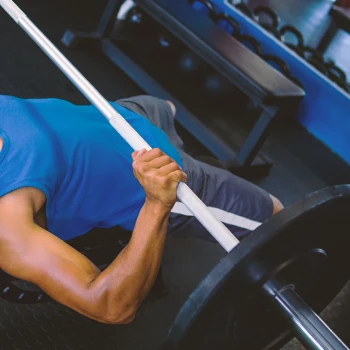
Function glutes are super important as they play a crucial role in knee joint strength [2].
Here are a few tips when doing this exercise:
- Maintain a tucked chin towards the chest as you extend your hips. This technique keeps your core engaged, preventing excessive torso arching and overextension of the spine.
- Lower the amount of weight if you can’t reach the full extension.
- Dedicate equal attention to both lifting and lowering the bar. This deliberate approach will effectively engage and challenge your glutes, compelling them to work harder throughout the exercise.
To perform a hip thrust, follow these steps:
- Sit on the ground with your back against a stable bench while bending your knees at a 90-degree angle and keeping your feet flat on the floor.
- Securely place a weighted barbell or a dumbbell across your hips, ensuring a firm grip.
- Engage your core muscles, then push through your heels to elevate your hips toward the ceiling, forming a straight line from your knees to your shoulders.
- At the top of the movement, contract your glutes, holding this position momentarily.
- Hold this position for three seconds while contracting your glutes before gradually lowering your hips to return to the initial position.
- Repeat for the desired number of repetitions.
“If you feel like your quadriceps muscles (the front of the thigh) are working too hard, your feet may be too close to your hips. Moving them further away from the body will help to shift the workload to the hamstrings and glutes. Moving them too far away will minimize the glutes and emphasize the hamstrings.”
- Malia Frey, Health Coach
4. Planks
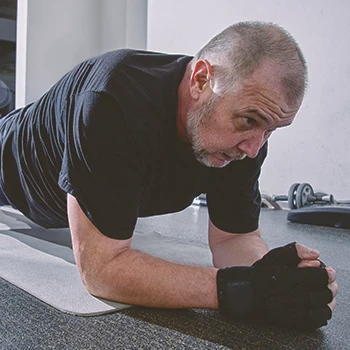
Planks are great exercises for building core strength, which I hold to be essential for men of any age.
Here are a few tips when performing planks:
- Avoid arching your back.
- Prevent your hips from sagging.
- Ensure that your neck remains aligned with your body, avoiding upward tilting that could strain the neck muscles. Instead, maintain a downward gaze towards the floor to promote proper alignment and prevent unnecessary strain on the neck.
To perform a plank, follow these steps:
- Get into a push-up position with your hands positioned shoulder-width apart and your arms fully extended.
- Gradually lower yourself down to your forearms, ensuring that your elbows align directly beneath your shoulders.
- Activate your core muscles and hold this position for as long as possible, keeping your body straight from your head to your feet.
- To release the position, slowly lower yourself down to the ground or come back up into a push-up position.
Related post: Does Planking Burn Fat
5. Lat Pull-downs
I've never met a strong person who has a weak back, which is why I love recommending this incredible back exercise to my clients.
Here are a few tips to perform this exercise well:
- By maintaining a neutral spine, you can safeguard your lower back from potential injuries.
- Ensure that your forearms are not bearing the burden of pulling the bar down; the effort should originate from your back. Activate your latissimus dorsi muscles by initiating the pull-down motion from your armpits.
- When gripping the bar, position your hands just slightly outside your shoulders, avoiding an excessively wide grip, especially if you are a beginner. Maintaining proper form as you lower the bar by ensuring your elbows point down rather than out to the sides.
To perform close grip lat pull-downs, follow these steps:
- Sit on a lat pull-down machine and adjust the thigh rest to fit against your legs, providing stability.
- Grasp the bar with an overhand grip slightly wider than shoulder-width apart.
- Sit down, maintaining a straight back and an upright chest position. Keep your feet flat on the ground for stability.
- Pull the bar down towards your torso, keeping your elbows close to your body.
- Hold for a few seconds, then slowly release the bar back to return to the starting position.
- Repeat for the desired number of repetitions.
“Stop at the point where your elbows would need to go backward to continue pulling the cable down. If the elbows go backward, it will put excessive stress on the shoulder joint. You should only lower the bar to your chin or just below.”
- Paul Rogers, Personal Trainer
Related: Standing Lat Pulldown 101 Guide
Workout Advice for Men Over 50

Here is some workout advice I've put together for men over 50 based on my experience over the years:
- Prioritize a physical check-up: Before embarking on any exercise program, it is vital to consult with your doctor and undergo a thorough physical check-up. This step will help identify any underlying medical conditions that might affect your ability to exercise safely.
- Begin with a gradual approach: Starting slowly and progressively raising the intensity and duration of your workouts is crucial. This method helps prevent injuries and allows your body to adapt to the new physical demands.
- Embrace cardio and strength training: Incorporate cardiovascular exercises and strength training into your routine. Cardio exercises enhance heart health and blood circulation, while strength training preserves muscle mass and bone density. A balanced combination of both types of exercise promotes overall fitness.
- Focus on flexibility and balance: As you age, prioritizing flexibility and balance becomes increasingly important to prevent falls and maintain mobility. Include exercises such as stretching and yoga in your regimen to improve flexibility and enhance balance.
- Maintain consistency: Consistency is key to achieving your fitness goals. Strive to stick to your exercise plan and integrate it as a regular part of your routine for optimal results.
- Listen to your body: Pay attention to your body's signals and avoid exercises or movements that cause discomfort or pain. If you encounter discomfort, stop the activity and seek advice from a fitness professional [3].
- Seek professional guidance: It is advisable to work with a certified personal trainer or fitness professional who can create a customized workout plan that suits your specific fitness level, goals, limitations, and medical conditions.
Related articles:
- 8 Best Multivitamins for Men Over 50
- Best Testosterone Booster for Men Over 50
- 5x5 Workout for Over 50 Years Old
FAQs
What Are the Best Workout Methods for Men Over 50?
The best workout methods for men over 50 are weight training, cardiovascular activity, resistance training, and flexibility work. This can help improve cardiovascular health, muscular mass preservation, flexibility, and overall well-being.
How Much Should a 50-Year-Old Man Workout?
A 50-year-old man should workout two to three times a week. The Centers for Disease Control and Prevention (CDC) recommend that adults, regardless of their age, participate in a minimum of 150 minutes of moderate activity per week. When it comes to lifting weights, men should complete three sessions per week, performing one or two exercises per muscle group.
What Exercises Should You Avoid After 50?
After 50, you should avoid the leg extension machine, behind-the-neck pull-down, pull-up, overhead press, bench press, and plyometric exercises.
What Are the Benefits of Exercises After 50?
The benefits of exercises after 50 are improved blood pressure, sleep, short-term memory, reduced heart disease risk, odds of diabetes, risk of falling, and pain.
References:
- https://www.webmd.com/healthy-aging/exercises-to-avoid-after-50
About The Author
You May Also Like
